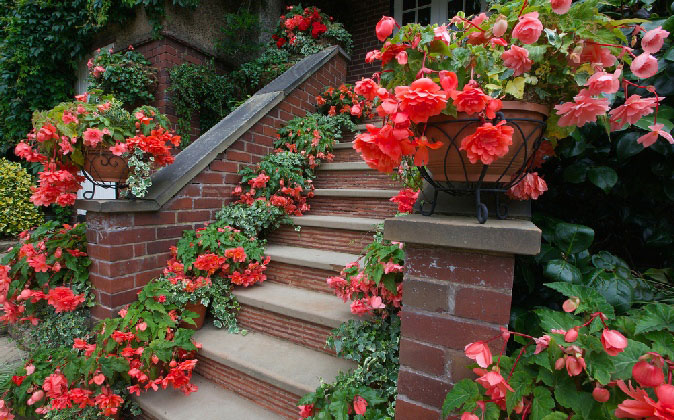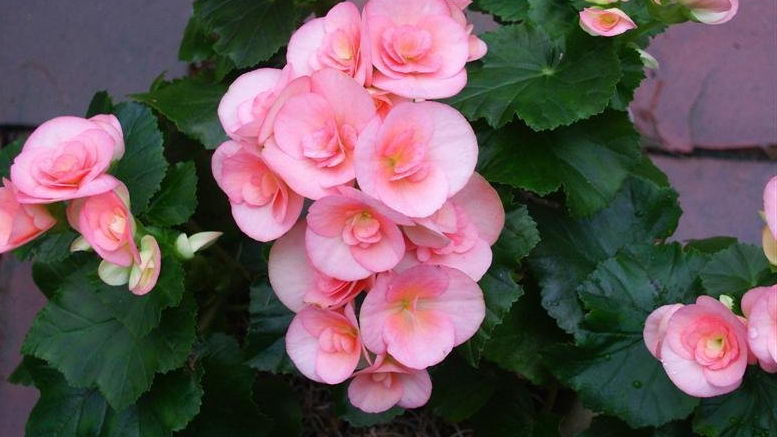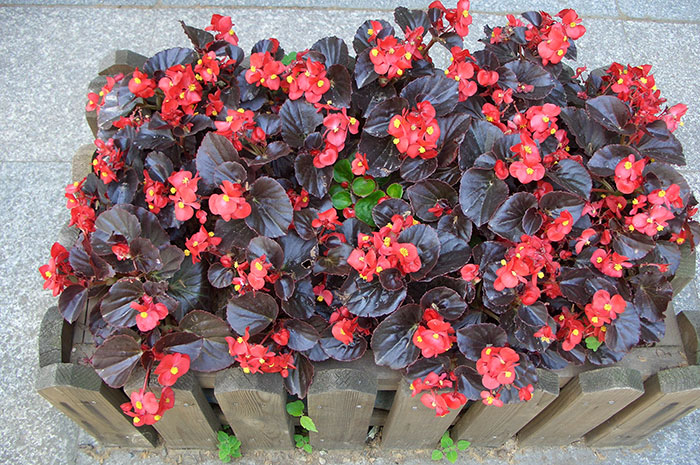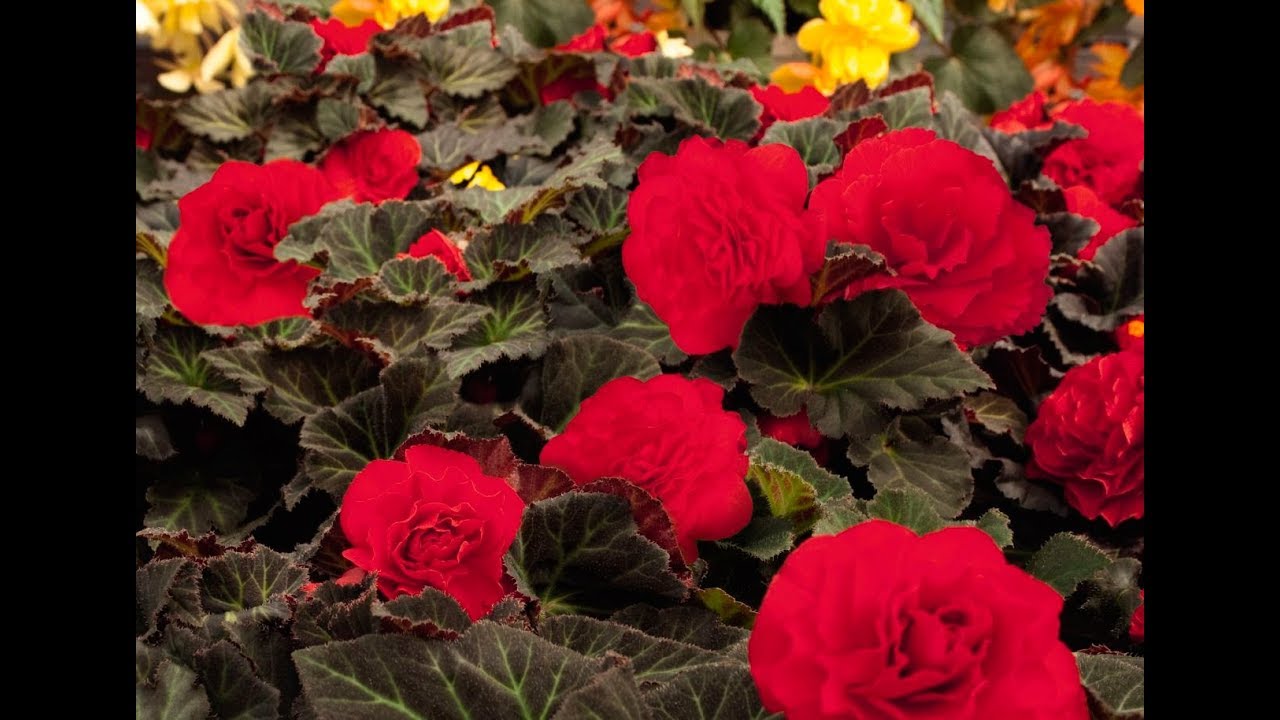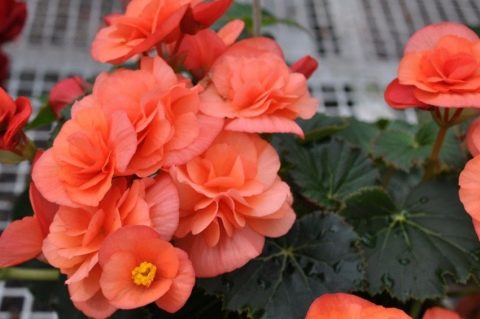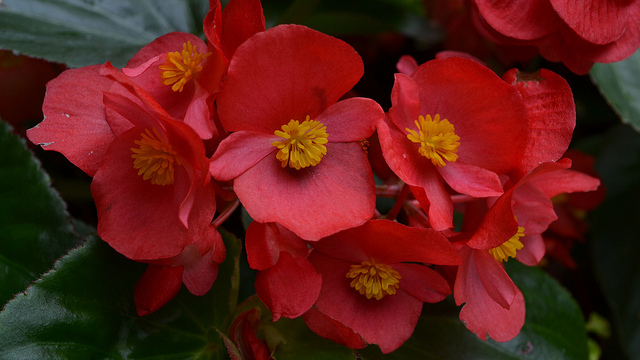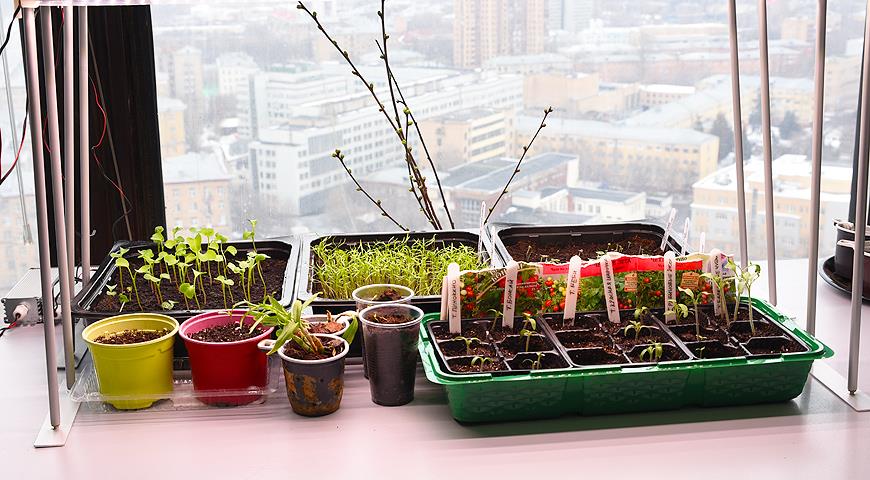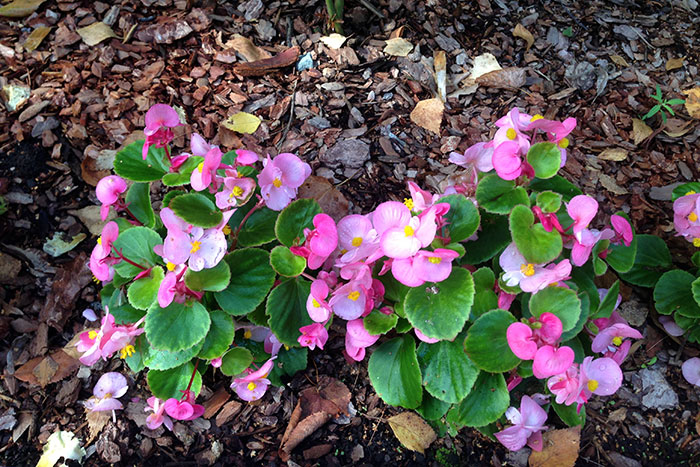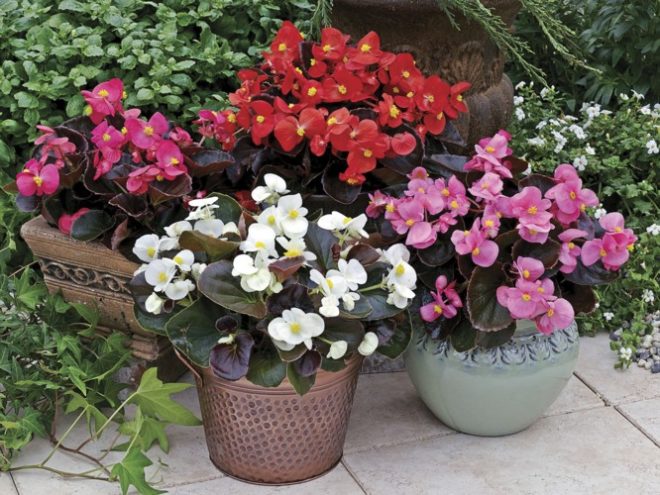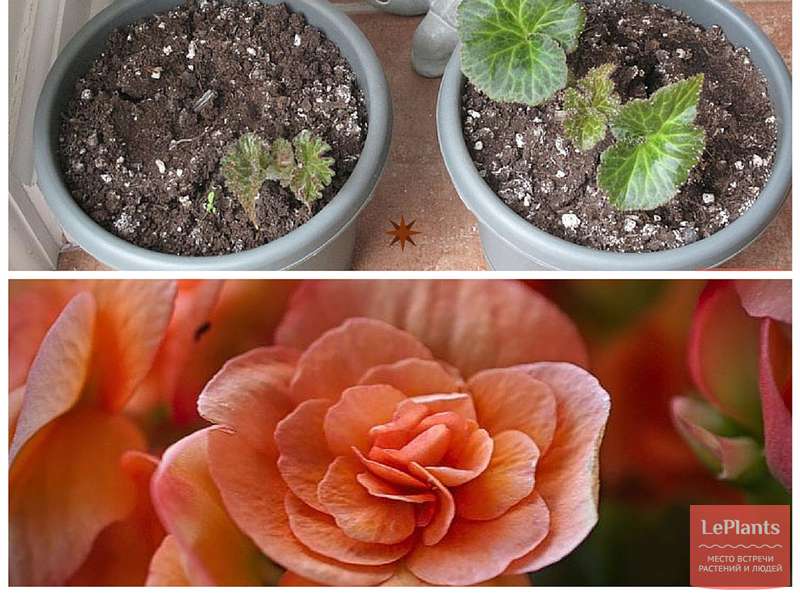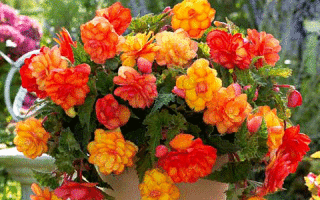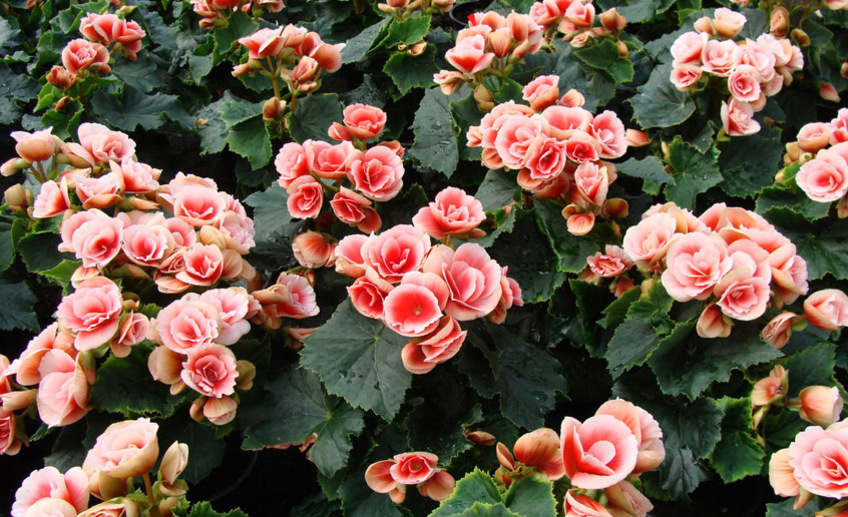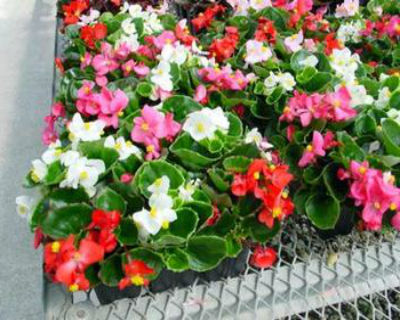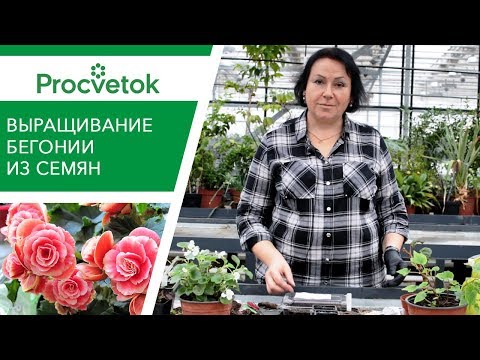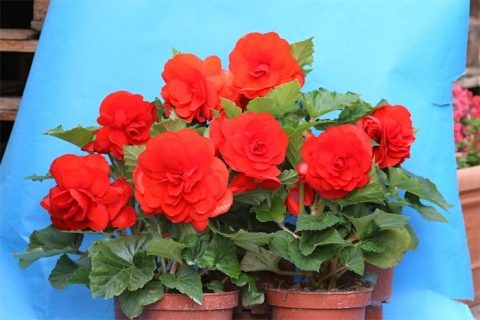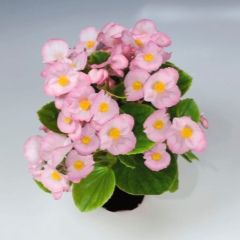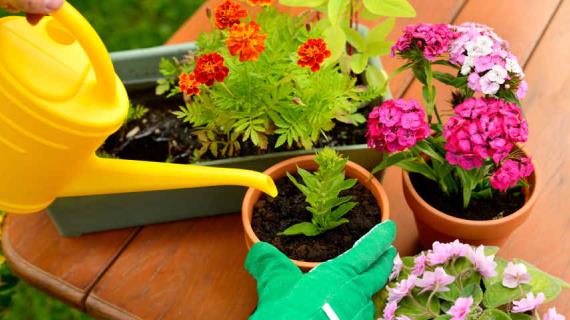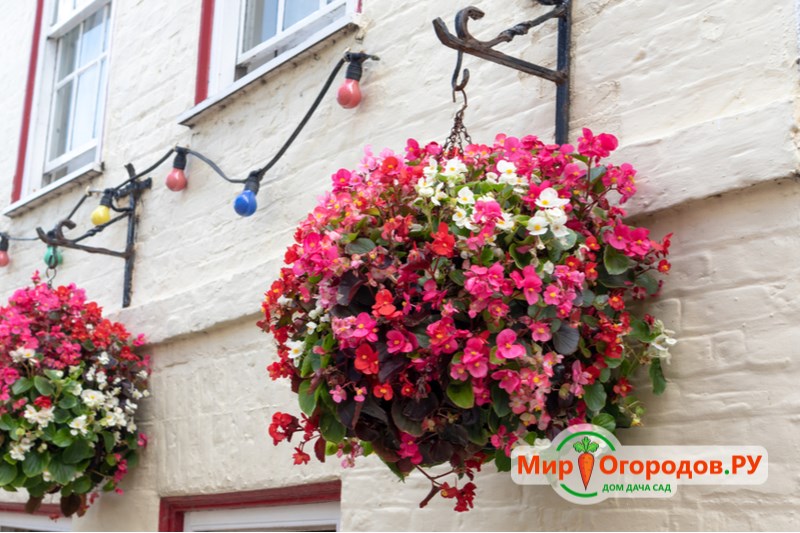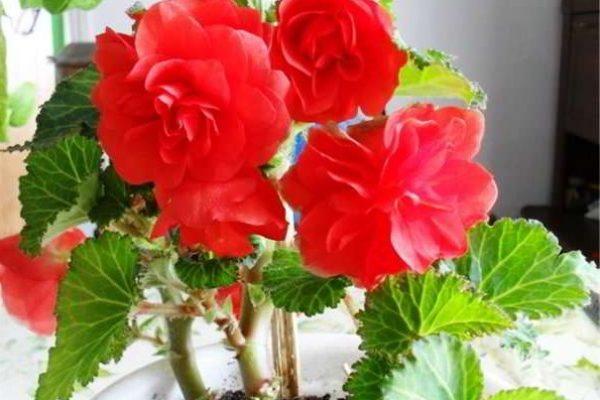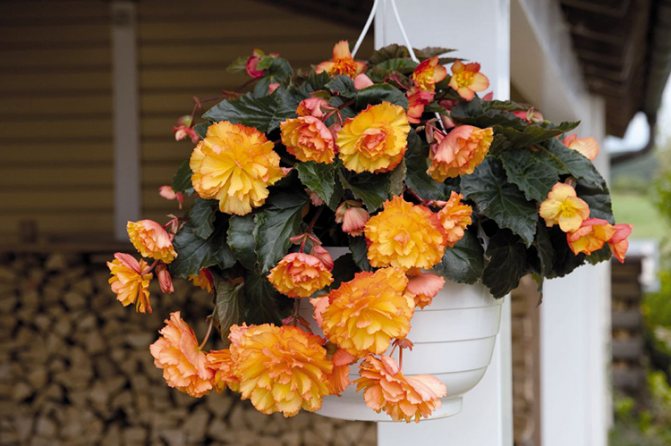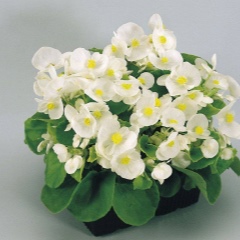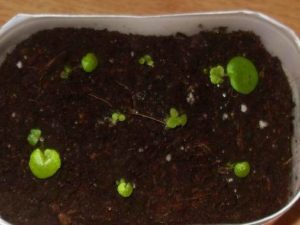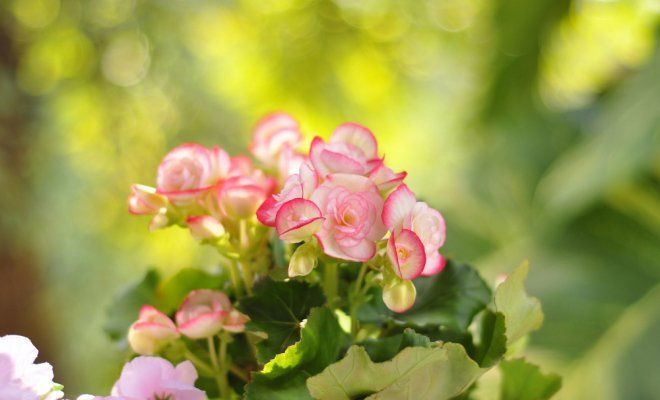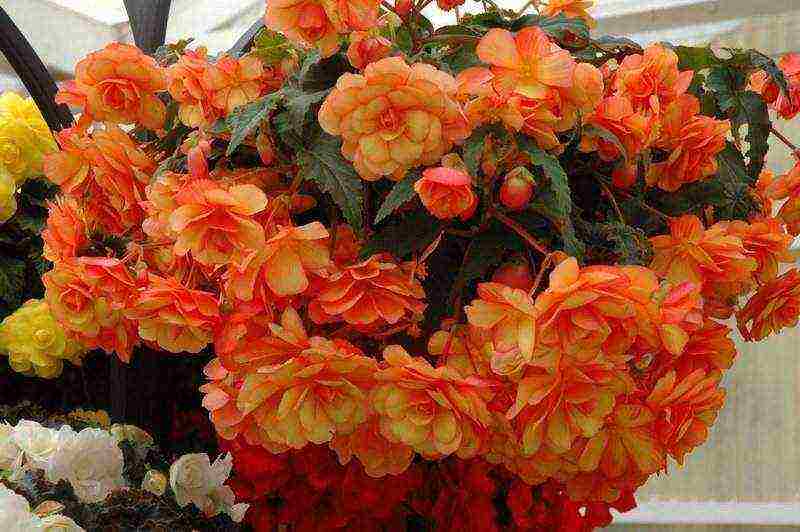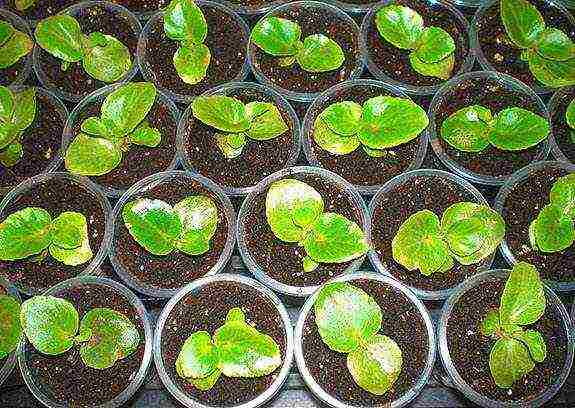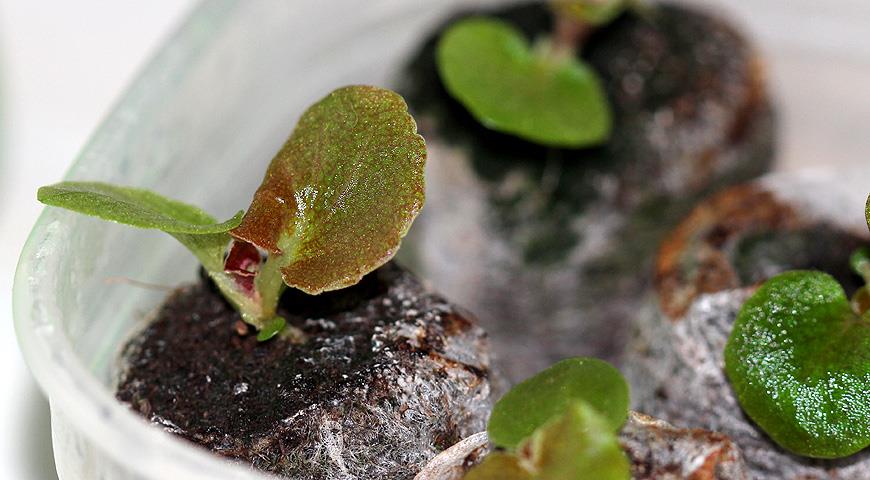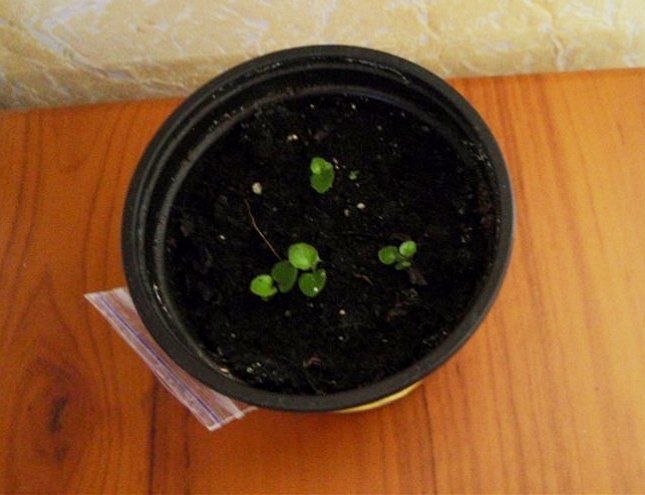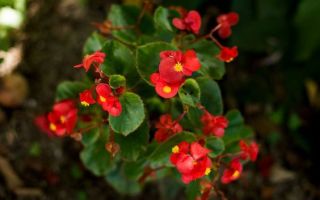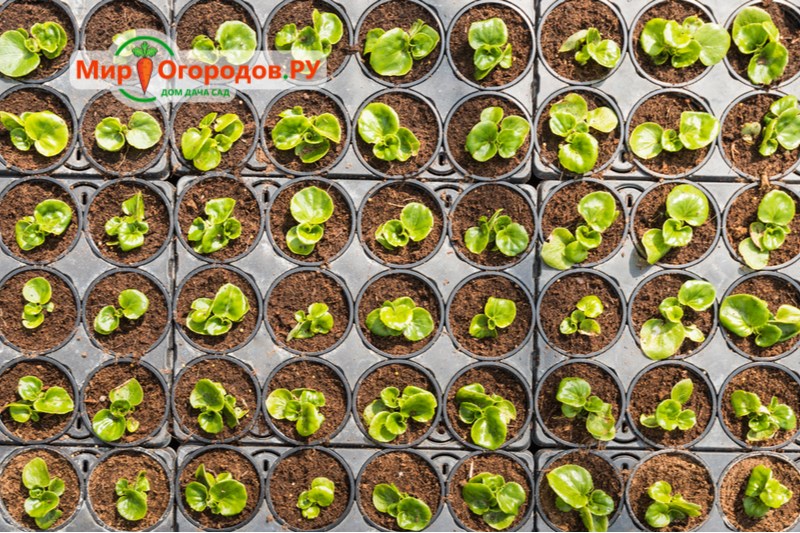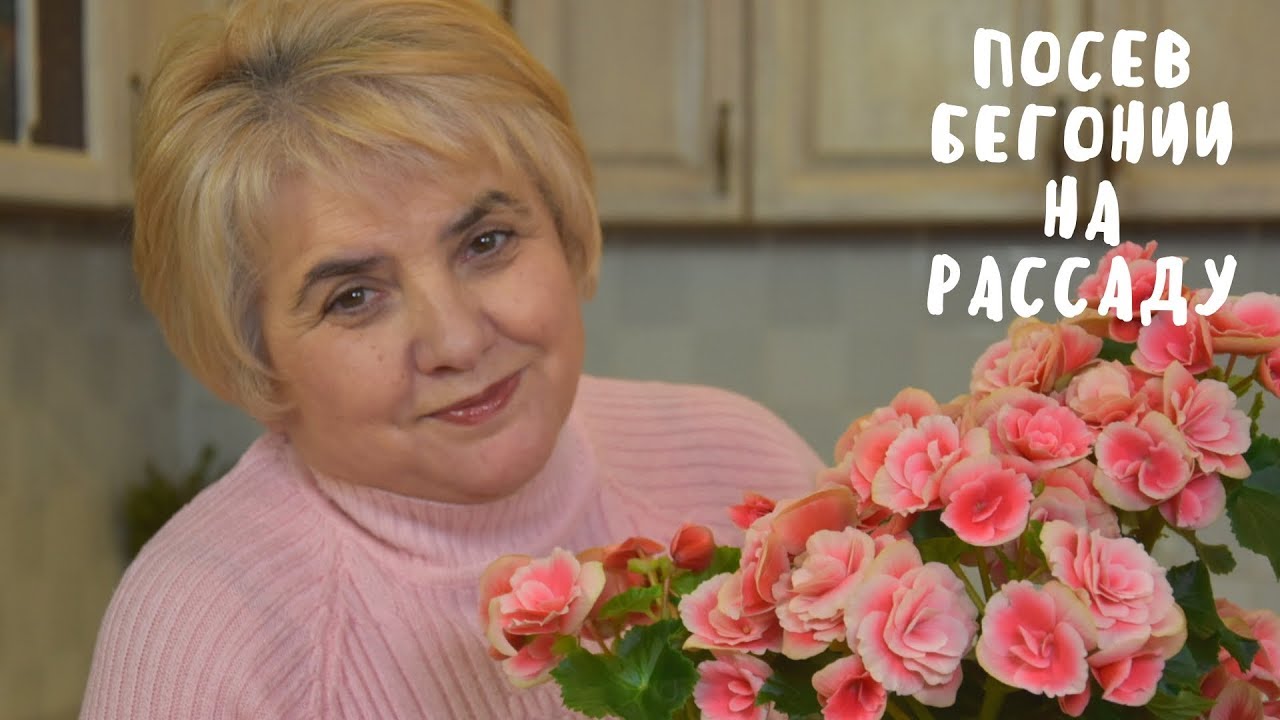When to sow begonia seeds?
Growing begonias from seeds will be successful if you know a few secrets. So, to germinate seeds, you need to create a humid microclimate, that is, to organize a greenhouse. The soil in which the seeds are planted is taken with a neutral pH, but light and loose. Coconut fiber can be added to the soil so that small begonias can cling to the fibers with their roots. The earlier the seeds are planted, the stronger the seedlings will be. High temperatures are not required for seed germination. The main thing here is light. Germination can also be carried out in natural light. But the emerging seedlings, especially in winter, must be supplemented with either a fluorescent lamp or a phytolamp.
Personal experience in planting tuberous begonias by seeds
So, before planting begonia seeds, I worked out a lot of information regarding the timing of planting, the conditions for germinating seeds and the subsequent care of the seedlings. When is begonia sown with seeds? Experts point out that sowing begonias with seeds is best done in November-December. Why? Firstly, seedlings obtained from early planting are in good health. Secondly, the tuberous begonia of November, December and January crops manages to form a tuber by the fall, the diameter of which is 2.5 cm. It is well stored in winter. Tuberous begonias, sown with seeds in February-March, manage to form by autumn tubers up to 1.5 cm. Some of them may not survive the winter.
The information that I learned from thematic forums on growing tuberous begonias from seeds was tested in practice. Looking ahead, I want to say that begonia planted in December develops faster and better than the plants sown in March. By the fall, seed begonia planted in December had formed a tuber with a diameter of 3.5 cm. This allowed her to survive the winter dormant period, in contrast to the begonias sown in March. The latter survived the winter, but came out of winter sleep for a long time and their flowering also came much later, compared to December begonias.

When does begonia bloom? On the forum I found interesting information about the timing of planting begonia seeds and its subsequent flowering. So, if the planting of begonias with seeds was carried out in November-December, then the ever-flowering varieties delight with buds 110-130 days after the appearance of the first shoots, tuberous varieties - for 150-155 days. If the planting of seeds was carried out in January-February, then ever-flowering begonia blooms as early as 105-115 days after germination, tuberous - on day 140. The flowering itself lasts 110-115 days and 98-112 days, respectively. If the seeds of room begonia were planted in February-March, then the flowering of ever-flowering varieties occurred 120-135 days after germination, tuberous - 175 days and lasted 83 days and 67 days, respectively.
How are things going in practice? Tuberous begonia seeds were planted on December 1st. I noticed seedlings on December 22. I'll tell you right away - the seeds were not fresh. Out of 10 seeds, only 2. The first buds appeared on the plants already on April 20, that is, from the moment of germination to flowering, about 120 days passed. Tuberous begonia seeds, which were planted on March 14, hatched after 3 weeks, that is, on April 4. They developed faster than the December crops. But when the summer sun began to bake, they stopped their growth, despite leaving, feeding and shading. Flowering came later and it happened 150 days after germination.
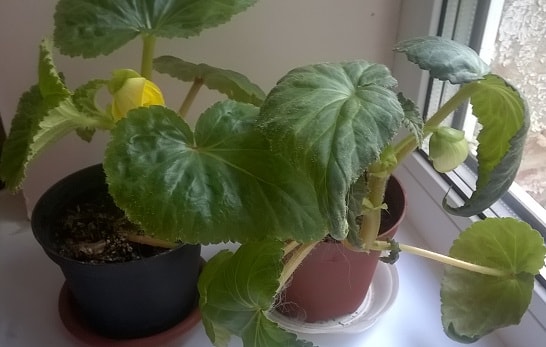
Classification
Decorative begonias for growing at home are divided into two main groups:
- Ornamental flowering begonias are an indoor herb with solid green leaves and flowers of various colors and shapes.
- Ornamental-deciduous begonias - a plant of the same type, but it stands out with an iridescent color of the leaves, flower ovaries are almost not formed.
In the photo above, you see a representative of the first group, and in the photo just below, a specimen representing the second class. As you already understood, in morphology, these two begonias differ slightly from each other. In a short description of the plant, we will note these differences.
Morphology
The main characteristic features of the structure of decorative begonia:
- roots - tuberous, fibrous or with a vertical main root, on which many processes are formed, the depth of occurrence is not more than 20-25 cm (the same type for both classes);
- begonia stems - erect, covered with fine hairs, the main color is green, but depending on the variety, it can have a different tonality, from light green tones to brown-purple shades (the same for species 1 and 2);
- leaves - you can talk about them endlessly, for each variety or hybrid of begonias, they are all different and peculiar in shape, color, structure, look at the photo:
- flowers are of an irregular asymmetric shape, unisexual and monoecious, that is, begonias cannot reproduce by self-pollination (in deciduous begonias, inflorescences, if they are formed, have no decorative value, it is better to destroy them so that the plant does not spend valuable nutrients on their development).
Varieties
Earlier, we have already noted that the number of begonia varieties is estimated at thousands. For example, let's make a brief description of the representatives of the blooming and deciduous varieties of the flower.
- Decorative flowering begonia of the Elatior variety (for growing at home). Flowering occurs twice a year in early summer and late autumn, flowers (up to 5 cm in diameter) have different very delicate shades of yellow, pink or red palette. There is also a rare snow-white "bunch" for this variety. The height of the bush is about 40 centimeters. Leaves are deep green in color. The stems are dense, foliage and flower ovaries are abundant.
- Begonia Mason decorative-deciduous is a squat bush (height 45-60 cm) with large leaves about 20 cm long. Stems are brownish-greenish or burgundy, covered with fine hairs. Leaves are fleshy, compressed, bright green in color with a pattern in the form of a cross in the center (highlighted by a brown spot contrasting with green), the surface of the leaves has a glossy sheen, the edges are serrated, the shape is oval, pointed at the end.
Here is a description of the most popular begonias that flower lovers grow at home. In what ways you can grow or plant this flower, we will consider further.
Reproduction
If you want to get several new plants at once, then you will come in handy breeding method of begonias leaf, in this case, take 2-3 large leaves, cut them in such a way that the large veins and the petiole remain intact. These parts are placed in a container with a moist substrate. A week later, small roots appear on the handle. The plant is ready to be transplanted to a new location.
With tuberous propagation, not many new begonia sprouts are obtained, no more than 2-3. The tuber must be cut so that two viable buds remain on each. These pieces are completely buried in the ground to a depth of 3 cm. The soil must be sufficiently moist, when drying it must be constantly moistened. The nodules will take root quickly, so they can be planted directly into a new pot.
Florists who want to get as many plants as possible use the method of growing begonias from seeds. It is easy to do this yourself at home. Let's dwell on this method and talk about it in more detail. In the video at the end of the article, you will clearly see how to do this correctly.
Interesting: Begonia Elatior - home care after purchase
Growing from seeds and care
Most often, this flower is propagated by cuttings, but growing from seeds is real. If it is possible to supplement the lighting with lamps, it is possible to sow begonias already in January.If there are no funds for early planting, then the end of March will also come up, when the daylight hours will be long enough.
Seedlings are sown in small containers with pre-prepared soil, but it is much easier to use peat tablets, which will eliminate the need for picking.
Begonia seeds are very small, like godetia, so it is difficult to evenly distribute them when planting.
For sowing in containers, this is not particularly important, since picking will still be required in the future. In turn, when planting in peat tablets, you can plant a shift in pairs using a moistened toothpick
Preliminary preparation of the seeds of this culture is not required. They are simply laid out on the surface of the soil and moistened from a spray bottle. Then they are covered with a film to obtain a greenhouse effect. It is not required to deepen or cover with soil.

Germination time is about fifteen days, during which the crops are ventilated (about an hour and a half a day) and, if necessary, moistened with a spray bottle. After germination, the film is removed and the crops are sent to the lightest possible room.
When the first pair of true leaves appears, a dive is made into small cups (five centimeters in diameter), and at the stage of six true leaves, another one is carried out (in a container with a diameter of ten centimeters), transplanted into a more spacious container, if possible together with an earthen lump. A weaker shoot is removed from the peat tablets at the stage of a pair of true leaves. After the pick, the temperature must be reduced to eighteen degrees so that the plant gradually gets used to its natural environment.
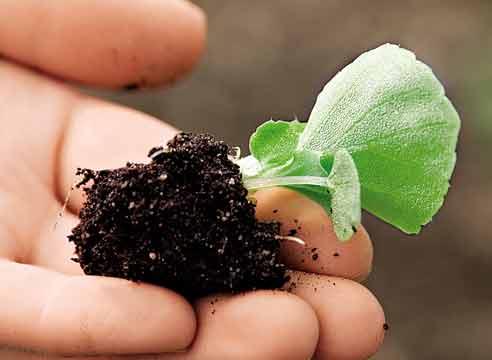
A transplant into open ground is carried out at the beginning of May, but only if there is no chance of frost. Plants in a flower bed can be planted quite thickly (from fifteen to twenty-five centimeters), which will create a great decorative effect. The transplant is carried out in the evening in a well-loosened and moist soil.
From the moment the first shoots appear to the beginning of flowering, depending on the selected variety, it takes up to four and a half months.
During the period of growth and the beginning of flowering, approximately every two weeks, the begonia is fed with ever-flowering mineral complexes, alternating nitrogen and phosphorus-potassium supplements.
When grown outdoors, this flower can be planted anew every year. But this is unnecessarily troublesome and it is better to transplant the flowers into pots and transfer them to a warm room for storage. All that remains in the flowerbed, alas, will die from frost.
In an apartment environment, it is not advisable to store begonia near heating radiators without additional illumination with lamps, since a warm climate in the absence of light can become destructive for it. However, it is worth taking care of the lighting, because in this case the begonia will delight you with picturesque flowering and all winter long.
How to grow begonia from seeds?
First of all, before you start sowing begonias with seeds, you should choose high-quality and convenient seed for you. In specialized stores, florists and gardeners can be offered two types of seeds: granular and ordinary, unprocessed.
Pelleted (granulated) seeds are easier to sow because, thanks to a special coating of nutrients, they become larger and are excellent for spot seeding in peat tablets. This method of seeding will allow you to bypass such traumatic for fragile young plants as a pick.
On this topic:
BACK
FORWARD
1 of 127
Before planting begonias with seeds in peat tablets, the tablets themselves should be placed on a pallet, well soaked in water, then placed on the surface of each of them granular seeds, moistened with water at room temperature (it is best to use a spray bottle) and covered with a plastic bag or plastic disposable glass in order to maintain the required moisture level. Watering the tablet with the sown seeds is done through the pallet, its moisture must be monitored very carefully, otherwise only the sprout that has formed will simply dry out.
If the temperature regime is 22 - 23 ° C, the first shoots will begin to appear after 14 days, then, after the formation of the third true leaf, the tablets with seedlings are planted in individual seedling pots, completely filling the peat mass with soil and thoroughly spilling the top layer with water at room temperature.
Sowing begonias with ordinary seeds, not covered with a shell, is most conveniently done in seedling boxes. For sowing, it is best to choose a light loose soil mixture with a large amount of peat in its composition, the main condition for the healthy development of begonia seedlings is the absence of stagnant water and good aeration, so you should take care of the correct drainage arrangement.
An important nuance in the question of how to plant begonia with seeds is the correct sowing technique: the seeds are placed on a moistened surface, well spilled with water from a spray bottle, after which the boxes with crops are covered with plastic wrap or glass. This is necessary in order to maintain the moisture level necessary for seed germination.
Watering must be done very carefully, make sure that the soil is moist, but no stagnation of water is created, which can lead to the development of fungal microflora that affects the weak delicate thin roots of seedlings.
The boxes should be placed in a room with good lighting, but at the same time protected from aggressive direct sunlight, which can only burn out the emerging sprouts, which should be expected 10 - 12 days after sowing, at a content temperature of 21 - 22 ° C.
On this topic:
BACK
FORWARD
1 in 65
Gradually, it is necessary to start hardening the seedlings, for which the film is slightly opened and the boxes with seedlings are left in this position for 10 - 15 minutes. Then the time of airing (hardening) and the degree of film opening increase, gradually accustoming the seedlings to the usual environment.
This technique also allows you to avoid the development of fungal microorganisms on the surface of the soil, which can occur on constantly moist soils if the temperature regime is not observed or with improper, excessive watering.
After the appearance of the third true leaf, the seedlings need to be picked into separate seedling pots. This process is quite laborious, requiring a lot of time, effort, patience and accuracy.
Plants are transplanted one at a time into a container filled with a light crumbly loose soil composition, spilled and set in a well-lit place, while the temperature gradually decreases to 20 ° C.
Transplant and further care
Begonia should be planted in open ground when the threat of frost has passed. The place is chosen sunny or in light partial shade with loose nutrient soil. When planting in groups, the distance between plants is 30-50 cm.
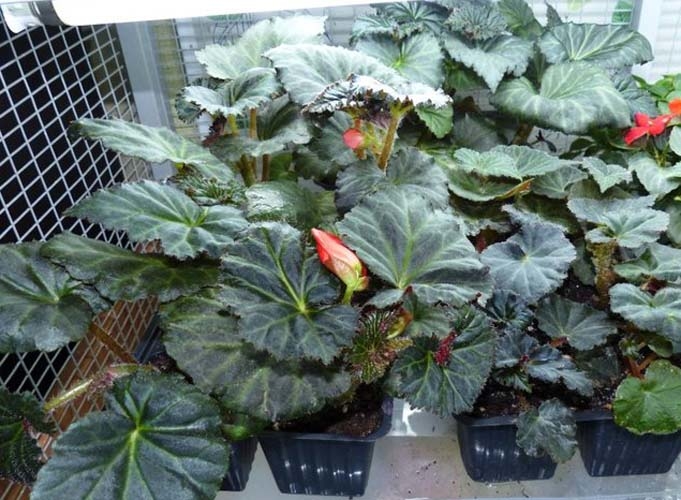
This is what seedlings look like, ready for planting.
- For planting in hanging pots or containers, containers are taken at the rate of 5-8 liters per plant.
- For home cultivation, the container should be wide, but not necessarily deep, the soil is loose, drained.
Further care consists in weeding, moderate watering, loosening the soil and feeding once a month with complex fertilizer.
Plant formation
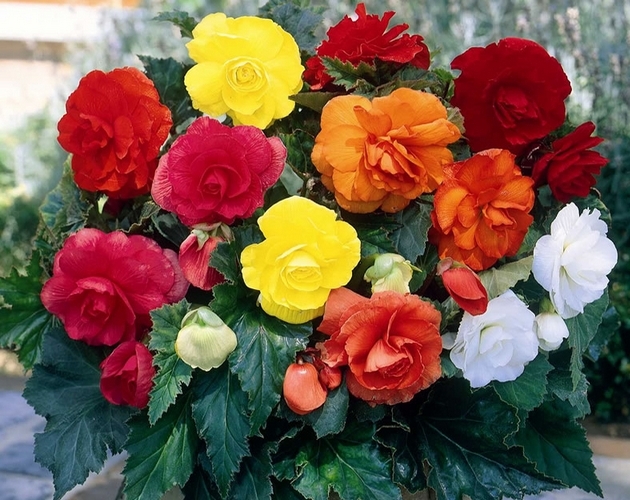
Simple techniques allow you to have a beautiful bush shape and long-lasting lush flowering.
Each flower lives no longer than 10 days, new ones appear in the place of the fallen ones. Flowering will be continuous with a large number of shoots with buds. To accelerate the formation of lateral shoots, the top of the stems 7–8 cm long must be pinched
This is especially important for ampelous forms.
In tuberous begonia, female and male flowers bloom on the same plant. Male flowers are characterized by large sizes and double shapes. Women are more modest: they are smaller and have only 4–5 smooth petals.To ensure a more lush flowering of male flowers, female flowers must be removed, since the vitality of the plant is spent not only on flowering, but also on the formation of fruits. If you want to get your own seeds, you can leave a couple of female flowers.
End of the flowering season
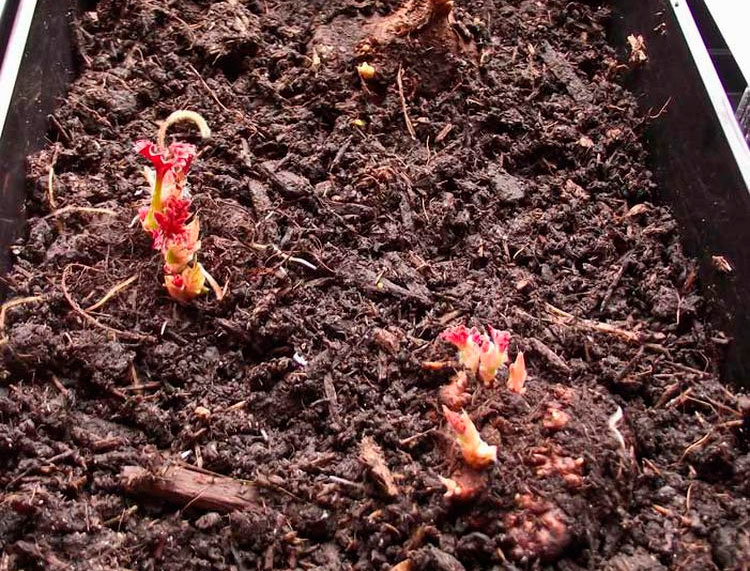
At the end of the season, when begonia stops blooming, you need to stop feeding and gradually reduce watering. Before the onset of frost, it is necessary to cut off the stems, dig up the tubers, clear them of the ground and treat them with a fungicide or potassium permanganate. Place the dried tubers in peat or sphagnum moss to protect them from drying out, wrap them in a plastic bag and put them in the vegetable storage area in the refrigerator.
When growing begonias as a perennial, you can place a pot or balcony container in the house and continue to care for the plants, and plant them in the garden in the spring.
Development problems: table of causes and remedies
Possible problems of development of tuberous begonia growing in the garden and indoors are approximately the same.
| Manifestation of the problem | Possible reasons | Solution |
| Lack of flowering | Low lighting | Move to a lit place |
| Heavy, non-breathable or waterlogged soil | Add baking powder to the soil and loosen in time | |
| Transplant damage | Feed with nitrogen fertilizer or organic matter | |
| Lack of nutrients | Feed with complex and potassium-phosphorus fertilizer | |
| Lack of a dormant period | Provide intensive care and feeding with organic matter or nitrogen fertilizer | |
| Dry air, insufficient watering | Regular watering, air humidification | |
| Pests | Use insecticides | |
| Variety ornamental foliage begonias | The reason is irreparable, you need to buy another variety | |
| Begonia variety that blooms after the sixth ring on the stem | Use a stimulant | |
| Plant aging | Rejuvenate using babies or cuttings | |
| The buds fall without blooming | Lack of nutrients | Feed with complex and nitrogen fertilizers, pick up special preparations |
| Leaves and buds fall | Overdrying air or soil | Moderate timely watering, air humidification |
| Pale foliage | Lack of light | Move the plant to a place with good lighting |
| Leaves turn yellow | Lack of water, minerals or the presence of parasites | Change the soil, treat the roots with potassium permanganate |
Home care
Begonia is a shade-tolerant plant, but with sufficient light, it will bloom more luxuriously. The optimal location for begonias is southwest or southeast windows.
In general, begonia is an unpretentious plant, but it can behave capriciously regarding watering.
Basic rules for watering
Begonia loves well-humidified air, but at the same time it does not tolerate an excess of moisture in the soil. Correct watering consists in observing the following rules:
- It is impossible to spray begonias, since the ingress of water on the leaves can provoke the appearance of yellow spots. Humidify the air with a conventional humidifier.
- In the summertime, it is recommended to place the begonia pots in a tray filled with wet gravel.
- In winter, it is best to put a bowl of water next to the plant. Its evaporation will provide optimal air humidity.
- Begonia is watered, as a rule, once every 2 - 3 days. In the heat, an increase in the frequency of watering is permissible, and in winter - a decrease up to 1 time in 5-7 days.
- It is necessary to water the begonia with settled tap water. If the water is too hard, it is recommended to pass it through a filter or use cooled boiled water.
Recommendations for moisturizing young seedlings
The root system of young seedlings of begonia develops very slowly, and at the initial stages is very weak
During this period, it is important to carry out proper watering, otherwise the thin and short roots of the seedlings may die.
In the period when the seeds have just hatched and the first sprouts have appeared, preference should be given to watering with a spray.
Even at this time, you can use the bottom irrigation system. It lies in the fact that boxes with seedlings are placed in a tray with water. Such watering will ensure the saturation of the soil with moisture and will not damage immature young plants.

